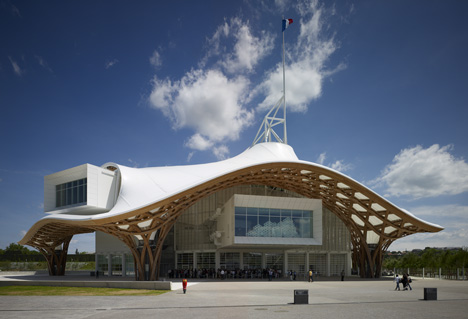ORIGINAL: Dezzen
24 March 2014
News: Japanese architect Shigeru Ban has been named as the 2014 laureate of the Pritzker Architecture Prize.
Shigeru Ban is best-known for projects such as the Cardboard Cathedral in New Zealand, and the Centre Pompidou Metz in France, but is also highly respected for his pioneering use of cardboard in disaster relief projects around the world.
He will become the second Japanese architect in a row to pick up the prestigious architecture prize, following on from last year's winner Toyo Ito, and will be the seventh to receive the accolade in its 36-year history.
Hearing the news, Ban said: "Receiving this prize is a great honour, and with it, I must be careful. I must continue to listen to the people I work for, in my private residential commissions and in my disaster relief work.
"I see this prize as encouragement for me to keep doing what I am doing - not to change what I am doing, but to grow."

Curtain Wall House
The architect began his career in the office of Arata Isozaka, after being educated in America at the Southern California Institute of Architecture, and then New York's Cooper Union School of Architecture.
He founded his own Tokyo practice in 1985 with little experience and went on to complete a number of residential projects in Japan such as Three Walls (1988), Curtain Wall House (1995) and Naked House (2000).

Naked House
His first designs for paper-tube structures were used to provide temporary homes for Vietnamese refugees after the Kobe earthquake in 1995. Since then the architect has travelled to sites of natural and man-made disasters around the world to develop low-cost, recyclable shelters for affected communities.
He has also used shipping containers as ready-made elements for permanent and temporary structures.
"Shigeru Ban is a force of nature, which is entirely appropriate in the light of his voluntary work for the homeless and dispossessed in areas that have been devastated by natural disasters," said jury chairman Peter Palumbo.
"But he also ticks the several boxes for qualification to the Architectural Pantheon: a profound knowledge of his subject with a particular emphasis on cutting-edge materials and technology, total curiosity and commitment, endless innovation, an infallible eye, an acute sensibility, to name but a few."

Paper Concert Hall in L'Aquila
Last year Ban completed a temporary cardboard cathedral for Christchurch (2013), after the city's former Anglican cathedral was destroyed by an earthquake. He has also designed an art museum for Aspen, Colorado, that is set to complete this summer.
The Pritzker Prize is presented annually to a living architect in recognition of contributions to both humanity and the built environment through architecture. Ban will receive a $100,000 prize and be presented with a bronze medallion in a ceremony on 13 June at the recently renovated Rijksmuseum in Amsterdam.
See also:




Comments
Post a Comment